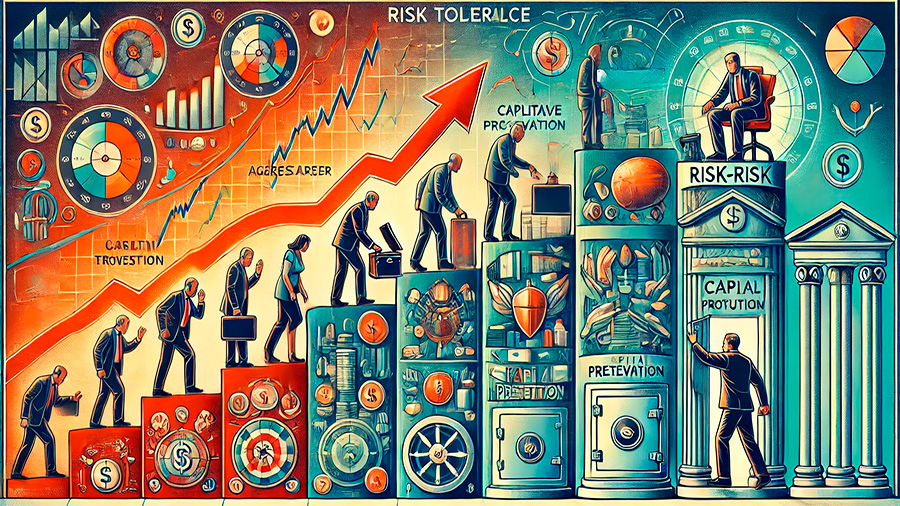Risk tolerance refers to your ability and willingness to endure fluctuations in the value of your investments. It’s a key factor that should guide your investment strategy, helping you decide how much risk you’re comfortable taking on. Understanding your risk tolerance allows you to make informed decisions about where to allocate your money, ensuring that your investment choices align with your financial goals, time horizon, and emotional comfort level. Whether you prefer safer, lower-return investments or are willing to accept higher risk for the possibility of greater returns, knowing your risk tolerance helps you build a portfolio that matches your personal financial profile.
Why Risk Tolerance Should Guide Your Investments
- Minimizes emotional decision-making: When your investments align with your risk tolerance, you are less likely to make panic-driven decisions during market volatility.
- Helps balance risk and reward: By understanding how much risk you can comfortably take on, you can strike a balance between protecting your capital and achieving your financial goals.
- Creates a personalized investment plan: Tailoring your investments to your risk profile ensures that your strategy suits your unique financial situation and long-term objectives.
Your risk tolerance serves as the foundation for your overall investment strategy, helping you make choices that you can stick with over the long term.
How to Assess Your Risk Tolerance
Before building your investment portfolio, it’s important to evaluate your risk tolerance. Risk tolerance is influenced by several factors, including your financial goals, investment timeline, and emotional response to market fluctuations. There are two main components to consider: your ability to take on risk (based on your financial situation) and your willingness to take on risk (based on your personal comfort level).
Factors That Determine Risk Tolerance
- Investment goals: If you’re saving for retirement decades away, you might be more willing to take on risk to maximize growth. However, if you’re nearing retirement or saving for a short-term goal, you may prioritize protecting your capital over chasing higher returns.
- Time horizon: The length of time you plan to invest plays a key role in determining your risk tolerance. Longer time horizons allow more room for recovery from market downturns, while shorter timeframes may require a more conservative approach.
- Financial stability: Your income, savings, and existing financial commitments affect your ability to take risks. If you have a stable income and a solid emergency fund, you may be able to tolerate more risk.
- Emotional comfort with volatility: Consider how you react to market drops. Are you able to remain calm and stay invested, or do losses make you anxious and prompt you to sell? Understanding your emotional response to market changes is critical in assessing your willingness to take on risk.
By assessing these factors, you can develop a clearer picture of your overall risk tolerance, which will guide your investment choices.

Investment Strategies for Different Risk Profiles
Once you’ve assessed your risk tolerance, you can tailor your investment strategy accordingly. Investors typically fall into one of three categories: conservative, moderate, or aggressive. Each risk profile corresponds to a different approach to asset allocation, which is how you divide your investments among various asset classes such as stocks, bonds, and cash.
Conservative Investors: Prioritizing Stability
- Typical asset allocation: 70% bonds, 20% stocks, 10% cash.
- Investment goal: Stability and consistent, if modest, returns.
Conservative investors have a low risk tolerance and prioritize preserving their capital over seeking high returns. If you fall into this category, you’re more likely to invest in assets that offer lower returns but with less volatility, such as bonds, cash, or dividend-paying stocks. This approach reduces the risk of significant losses during market downturns but also limits the potential for rapid growth.
Moderate Investors: Balancing Risk and Return
- Typical asset allocation: 50% stocks, 40% bonds, 10% cash.
- Investment goal: Achieving growth while managing volatility.
Moderate investors are willing to accept some risk in exchange for the potential for higher returns. If you’re a moderate investor, you prefer a balanced portfolio with a mix of equities and fixed-income assets. This approach provides both growth potential and downside protection, offering a middle ground between conservative and aggressive strategies.
Aggressive Investors: Maximizing Growth Potential
- Typical asset allocation: 80% stocks, 15% bonds, 5% cash.
- Investment goal: Maximizing long-term capital appreciation.
Aggressive investors are comfortable taking on high levels of risk to achieve greater potential returns. If you’re in this category, you focus heavily on stocks or other growth-oriented investments, accepting market volatility as part of your long-term strategy. While this approach can lead to higher returns over time, it also means enduring more significant market fluctuations.

Adjusting Your Investment Strategy Over Time
Your risk tolerance is not static. It can change over time as your financial situation, goals, and market conditions evolve. For example, as you get closer to retirement, your focus may shift from growth to capital preservation, prompting a more conservative approach. Regularly reviewing your investment strategy ensures that it continues to align with your risk tolerance and financial objectives.
When to Reassess Your Risk Tolerance
- Life events: Major life changes, such as getting married, buying a home, or having children, can alter your financial situation and risk tolerance.
- Market shifts: During periods of extreme market volatility, you may want to reassess your tolerance for risk and adjust your portfolio if needed.
- Approaching financial milestones: As you near significant financial goals, such as retirement, you may need to transition to a more conservative strategy to protect your investments.
Regularly reassessing your risk tolerance and adjusting your portfolio ensures that your investments continue to support your long-term goals.
Balancing Risk and Diversification
Regardless of your risk tolerance, diversification is a crucial element of any investment strategy. Diversifying your portfolio means spreading your investments across different asset classes, sectors, and geographical regions to reduce the impact of poor performance in any single area. Diversification helps manage risk by ensuring that your portfolio is not overly reliant on the success of one asset class, industry, or market.
How Diversification Reduces Risk
- Asset class diversification: By investing in a mix of stocks, bonds, and cash, you can reduce the risk associated with market downturns while still participating in growth opportunities.
- Sector diversification: Spreading your investments across various industries (e.g., technology, healthcare, and finance) helps reduce the impact of poor performance in any one sector.
- Geographical diversification: Investing in both domestic and international markets offers exposure to global growth opportunities while managing regional risks.
Diversification is essential for investors of all risk profiles, as it helps mitigate risk without sacrificing the potential for long-term returns.
Final Thoughts: Aligning Your Investment Strategy with Your Risk Tolerance
Your risk tolerance plays a central role in shaping your investment strategy. By assessing your financial goals, time horizon, and comfort with market fluctuations, you can build a portfolio that aligns with your personal risk profile. Whether you’re a conservative, moderate, or aggressive investor, understanding your risk tolerance will help you make smarter decisions, avoid emotional reactions to market changes, and stay committed to your long-term financial plan. Remember, your risk tolerance may change over time, so it’s essential to regularly review and adjust your investments to ensure they continue to meet your needs.
By aligning your investment strategy with your risk tolerance, you can confidently pursue your financial goals while managing the risks associated with investing.

